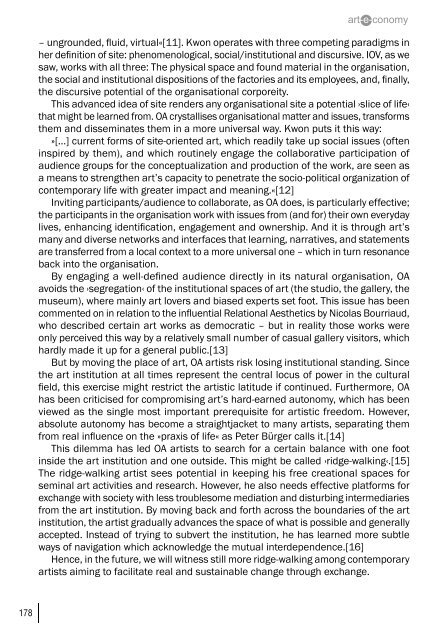art-e-conomy _ reader - marko stamenkovic
art-e-conomy _ reader - marko stamenkovic
art-e-conomy _ reader - marko stamenkovic
Create successful ePaper yourself
Turn your PDF publications into a flip-book with our unique Google optimized e-Paper software.
178<br />
– ungrounded, fluid, virtual«[11]. Kwon operates with three competing paradigms in<br />
her definition of site: phenomenological, social/institutional and discursive. IOV, as we<br />
saw, works with all three: The physical space and found material in the organisation,<br />
the social and institutional dispositions of the factories and its employees, and, finally,<br />
the discursive potential of the organisational corporeity.<br />
This advanced idea of site renders any organisational site a potential ›slice of life‹<br />
that might be learned from. OA crystallises organisational matter and issues, transforms<br />
them and disseminates them in a more universal way. Kwon puts it this way:<br />
»[…] current forms of site-oriented <strong>art</strong>, which readily take up social issues (often<br />
inspired by them), and which routinely engage the collaborative p<strong>art</strong>icipation of<br />
audience groups for the conceptualization and production of the work, are seen as<br />
a means to strengthen <strong>art</strong>’s capacity to penetrate the socio-political organization of<br />
contemporary life with greater impact and meaning.«[12]<br />
Inviting p<strong>art</strong>icipants/audience to collaborate, as OA does, is p<strong>art</strong>icularly effective;<br />
the p<strong>art</strong>icipants in the organisation work with issues from (and for) their own everyday<br />
lives, enhancing identification, engagement and ownership. And it is through <strong>art</strong>’s<br />
many and diverse networks and interfaces that learning, narratives, and statements<br />
are transferred from a local context to a more universal one – which in turn resonance<br />
back into the organisation.<br />
By engaging a well-defined audience directly in its natural organisation, OA<br />
avoids the ›segregation‹ of the institutional spaces of <strong>art</strong> (the studio, the gallery, the<br />
museum), where mainly <strong>art</strong> lovers and biased experts set foot. This issue has been<br />
commented on in relation to the influential Relational Aesthetics by Nicolas Bourriaud,<br />
who described certain <strong>art</strong> works as democratic – but in reality those works were<br />
only perceived this way by a relatively small number of casual gallery visitors, which<br />
hardly made it up for a general public.[13]<br />
But by moving the place of <strong>art</strong>, OA <strong>art</strong>ists risk losing institutional standing. Since<br />
the <strong>art</strong> institution at all times represent the central locus of power in the cultural<br />
field, this exercise might restrict the <strong>art</strong>istic latitude if continued. Furthermore, OA<br />
has been criticised for compromising <strong>art</strong>’s hard-earned autonomy, which has been<br />
viewed as the single most important prerequisite for <strong>art</strong>istic freedom. However,<br />
absolute autonomy has become a straightjacket to many <strong>art</strong>ists, separating them<br />
from real influence on the »praxis of life« as Peter Bürger calls it.[14]<br />
This dilemma has led OA <strong>art</strong>ists to search for a certain balance with one foot<br />
inside the <strong>art</strong> institution and one outside. This might be called ›ridge-walking‹.[15]<br />
The ridge-walking <strong>art</strong>ist sees potential in keeping his free creational spaces for<br />
seminal <strong>art</strong> activities and research. However, he also needs effective platforms for<br />
exchange with society with less troublesome mediation and disturbing intermediaries<br />
from the <strong>art</strong> institution. By moving back and forth across the boundaries of the <strong>art</strong><br />
institution, the <strong>art</strong>ist gradually advances the space of what is possible and generally<br />
accepted. Instead of trying to subvert the institution, he has learned more subtle<br />
ways of navigation which acknowledge the mutual interdependence.[16]<br />
Hence, in the future, we will witness still more ridge-walking among contemporary<br />
<strong>art</strong>ists aiming to facilitate real and sustainable change through exchange.


